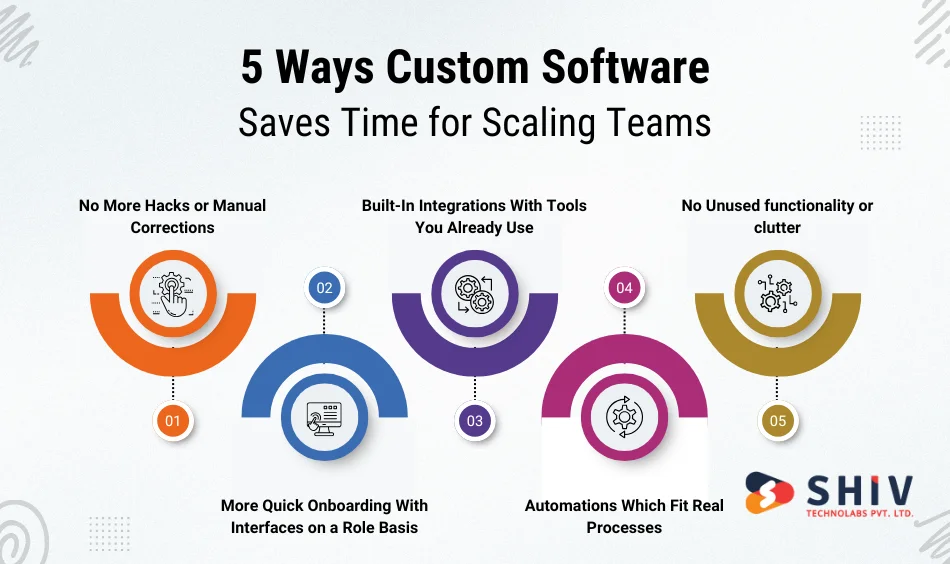Table of Contents
Every high-growth team reaches a wall. Perhaps it is the presence of CRM that does not seem to align with your sales process. Or the project tool, with which it would take five clicks where one should suffice. Or better yet (or worse), spreadsheets, which are duct taping departments in place when your business is losing hours a week.
The reality is that growth increases inefficiencies. And without the correct software, buoyancy is a disaster of wasted efforts and overlooked deadlines. Companies are wasting up to 30% of their productive hours due to poor systems.
That is where the debate between Off the shelf vs custom software becomes practical. Fast is off-the-shelf. Does it, however, fit? It will require more time to build custom software for business, but in the long term, it will save time by eliminating all those workarounds. What, then, is correct at this stage of your team?
Off-the-Shelf Software: Fast, Affordable, but Not Always a Perfect Fit
Off-the-shelf software is pre-made software designed to address typical business needs. In your mind, imagine Slack, Trello, QuickBooks, or Zoho CRM. You subscribe, and you are ready in minutes. It is the default approach used by startups and small groups in an attempt to move quickly.
Here are the Advantages of Off-the-Shelf software solutions
- Speed to Deploy: Installation is frequently at once or only a few clicks.
- Reduced Upfront Expenses: You have a subscription fee as opposed to investing into development.
- Continuous Updates: This typically includes regular fixes, support, and customer services.
- Field Tested: It is very popular, meaning you benefit from tested UX and stability.
Then Here Is the Catch…
The off-the-shelf software might be a limit to your company growth rather than a takeoff:
- Flexibility: You adapt the tool to suit your processes, not the other way around.
- Too Much Tooks: Each department chooses a variety of apps, resulting in the separation of data and awkward working processes.
- Hidden Time Costs: Repetitive tasks, manual data entry, and switching between apps suck up time fast.
What is Custom Software?
Custom software is tailored software solutions that suit your business needs to a great extent. It is not a standard solution; it comes with a customizable touch that may not fit every other organization. When it comes to custom software, your development team needs to build custom CRM and ERP solutions tailored to your team’s specific requirements.
Here are Common Use Cases for Custom Solutions:
- Custom CRMs/ ERPs: Made to your sales process or supply chain
- Project Management Systems: Architected to your deliverables, dependencies, and models of resources
- Customer Portals or SaaS Products: UX Personalized and data flows
Below are the Essential Benefits Of customizable software:
- Custom Fit: All the screens, buttons, and features fit your real process.
- End-to-End Control: You control the roadmap, the features, and the priorities.
- Future-Ready: Grow and move without standing in line.
The trade-off? Deploying customizable software requires additional planning, investment, and time. However, how you spend that time later, in terms of automation, efficiency, and completeness, is revolutionary.
5 Ways Custom Software Saves Time for Scaling Teams

Now, what is the reality? This is where customized software solution really comes in handy, saving you hours rather than minutes.
1. No More Hacks or Manual Corrections
When you use off-the-shelf tools, you usually end up creating Google Forms, side spreadsheets, or even Slack hacks to achieve what the software should deal with. Custom software eradicates those loopholes. It is based on your way of working; therefore, the tool will do what it must, with no band-aids necessary.
2. More Quick Onboarding With Interfaces on a Role Basis
Custom software can also provide clean and contextualized views to a user instead of having to train each new employee on a bloated platform. To sales, pipelines are regarded. Ops observes orders. Managers look at reports. Nothing in the way, no muddle. This will result in a faster onboarding process, fewer errors, and increased productivity.
3. Built-In Integrations With Tools You Already Use
Instead of struggling with five separate platforms, it is possible to automate the transfer of data between your CRM, email, finance, or logistics software with the help of custom solutions. It is not that he is talking about syncing data; it is designing logic around it. Never again two entries. No copy-pasting anymore.
4. Automations Which Fit Real Processes
Generic off-the-shelf automation is typical. On demand, you can automatically determine what you want through custom software vulnerability alerts, task creation, document processing, approvals, and reports, among other things. You are quicker in working, as your computer works similarly to you.
5. No Unused functionality or clutter
When using SaaS tools, you get to pay for what you do not use and overdo them daily. Targeted software is streamlined in nature. You only create what you require; thus, teams are concentrated and work without distraction.
Feature-by-Feature Comparison: Off-the-Shelf vs Custom Software
Now, let’s take a look at the feature-by-feature comparison of off-the-shelf vs. customized software solutions.
| Feature | Off-the-Shelf Software | Custom Software |
|---|---|---|
| Setup Time | Instant to a few days | Weeks to months (initial build phase) |
| Flexibility | Limited to vendor-defined settings | Fully customizable to your processes |
| Scalability | May hit limitations as team grows | Built to scale with your business |
| Cost Over Time | Low upfront, recurring monthly fees | Higher upfront, lower long-term cost |
| Maintenance | Handled by vendor | Handled by your dev team or partner |
| Integration | May require third-party connectors | Natively integrates with your tools |
When Off-the-Shelf Software Becomes a Bottleneck
At some point, there is a tip that something that was making you move faster is slowing you down.
Red Flags Indicating You Are Out of Off-the-shelf Software
- You are using several tools to perform one task
- External processes are being monitored outside the platform
- Sign-offs and upgrades demand prolonged email projects
- Employees in the team lament over the routinely, monotonous chores
It is when software ceases to be a solution but becomes a problem. Off-the-shelf tools do not always fit. That is, when you and your business are unique (and procedures are unique), custom begins to sound much better.
Custom vs. Off-the-Shelf Software: How to Choose Based on Your Business Stage

It does not always happen to be about custom or off-the-shelf. At times, it is time to change the switch. This is how to consider the decision.
When Off-the-Shelf Still Works
- You are a small organization and trying to go fast
- Your operations are in their growing stages
- Before investing in a workflow, you must validate it.
- The finances are low, and quickness counts rather than fitness
When Custom Becomes the Smart Move
- Your software is spending more time on repairs than in use
- You have made too many workarounds
- You require greater integration or categorized industry-specific activities.
- You do not want to grow and switch platforms after 6 months.
The actual ROI of custom software will manifest itself once it is launched, when your team starts spending less time every week doing everything once, doing it right, and doing it automatically.
Conclusion
Custom software is not faster on the first day, but it can save your time on the 100th day. Your software should not keep pace with your team; it should never be the one that drags you down.
Commercial, off-the-shelf, is a wonderful baselining point. However, it is not the lasting solution to teams seeking clarity, speed, and control. That is why you should not be satisfied with duct-taping your tools together or training people around readily available software that just fits.
Make something that operates as you operate.
At Shiv Technolabs, we specialize in developing custom software solutions that go well with your business requirements. Regardless of your sales process, tool consolidation needs, or internal system requirements that simply make sense, we will help you design, build, and evolve it.
Reach out to us at Shiv Technolabs with your agile software for business, and let’s turn your growth into momentum.






















